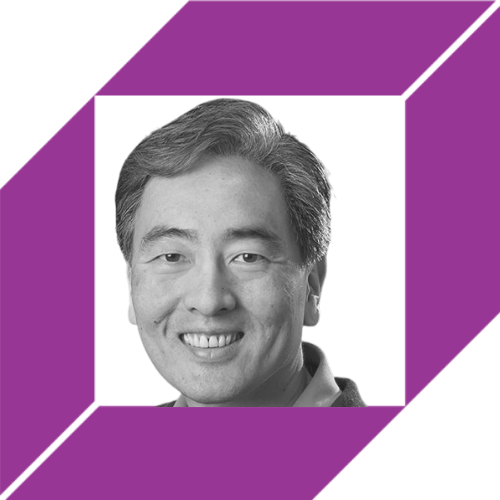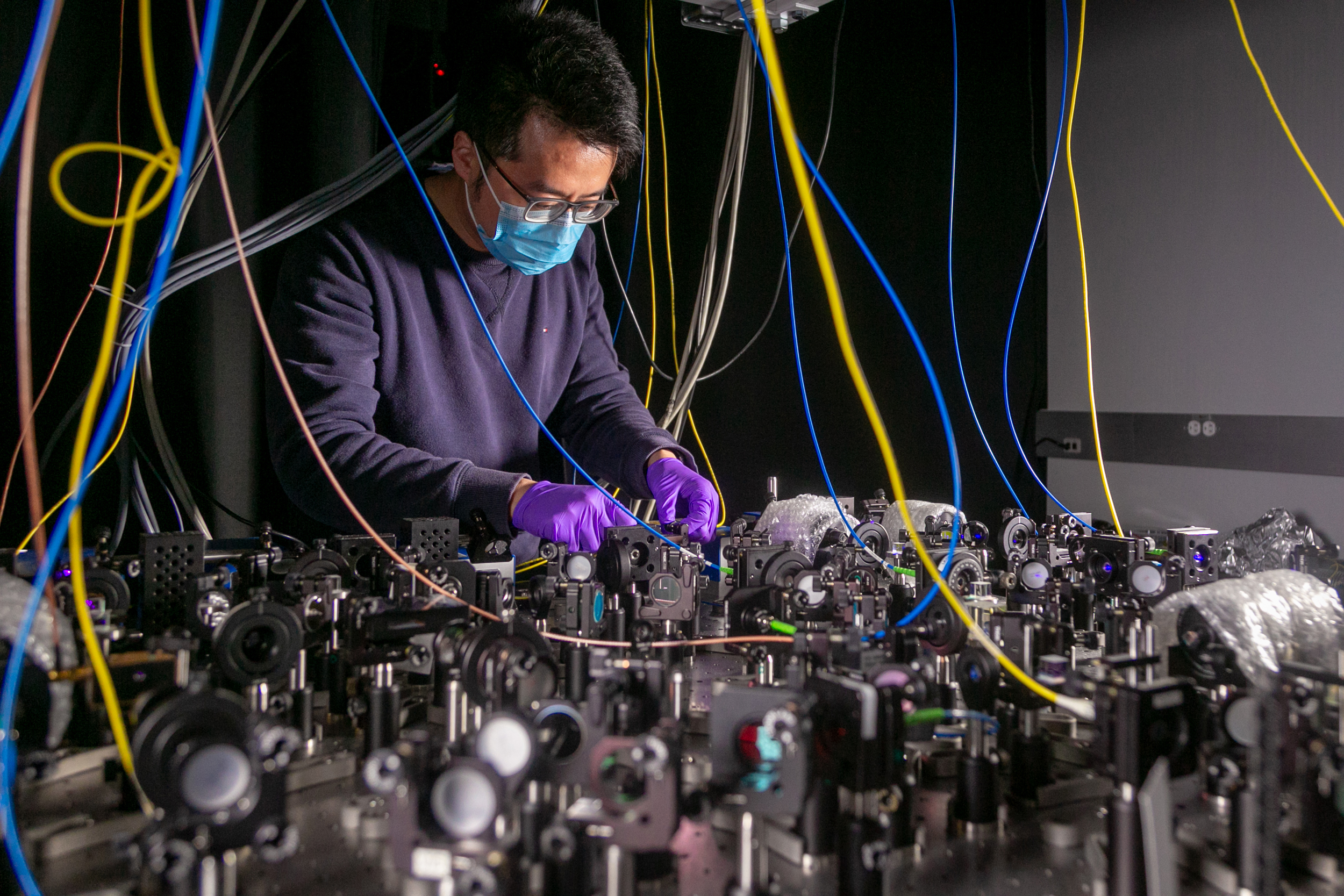Research
‘More Possibilities Than There Are Particles in the Universe’
‘More Possibilities Than There Are Particles in the Universe’
Duke Building a World-Class Team for the Quantum Computing Race
Jungsang Kim was a bit of an anomaly at Duke when he joined the faculty in 2004. Fresh out of the telecommunications industry, and with a PhD in physics from Stanford, Kim soon filled his new Duke lab in electrical and computer engineering with delicate, complex constructions marrying physics and engineering: reconfigurable optical systems whose tiny mirrors—each about the span of a single eyelash—were micro-machined from silicon and designed to work in parallel to precisely steer beams of laser light.
The next year, Kim published a proposed optical approach to ion trapping – holding a charged atom in place with electromagnetic fields and manipulating them with laser light -- and made it official: Duke had its first quantum information lab.
Kim was in the vanguard of the growing field of physicists and computer architects dreaming of a quantum computer—a machine that in theory could explore vast numbers of possible outcomes simultaneously, addressing problems much too dense for even the best classical supercomputers to tackle. With a functioning quantum computer, problems abandoned as intractable long ago, like creating accurate models of weather systems or predicting the ebbs and flows of financial markets, could be dusted off and brought back to the table.
Kim’s single lab has now drawn an entire constellation of quantum computing experts into its orbit at Duke.
Among the first were quantum information theorist Iman Marvian, a postdoc at MIT, and Kim’s long-distance collaborator Kenneth Brown, a faculty member at Georgia Tech and an expert in quantum control and error correction. Brown was initially skeptical about Duke’s potential to build a quantum center.
 Jungsung Kim
Jungsung Kim“When I came from Georgia Tech to interview, Dean [Ravi] Bellamkonda suggested there could be future growth in quantum information at Duke beyond hiring Iman and me. This was promising, but I assumed he was just sweet-talking me,” said Brown, who nonetheless accepted the offer. “I was wrong.”
With new support from the Duke Endowment to hire top-level new faculty in science and technology, Kim and Brown have been empowered to recruit outstanding colleagues at the forefront of quantum computing, including some senior faculty and long-term collaborators.
“Word got out in the community that Duke was serious about quantum information and willing to put in the resources,” said Brown.
In the coming year, a trio of quantum information scientists and engineers will further expand Duke’s quantum capabilities when they transition from the University of Maryland: physicist Marko Cetina, quantum experimentalist Crystal Noel, and Kim’s and Brown’s longtime collaborator and the architect of the U.S. National Quantum Initiative, Chris Monroe.
 Chris Monroe stands in front of the Chesterfield Building.
Chris Monroe stands in front of the Chesterfield Building.Construction is currently underway on a 10,000-square foot expansion of Duke’s existing quantum computing center in the Chesterfield Building, a former cigarette factory in downtown Durham. The new space will house what is envisioned to be a world-beating team of quantum computing scientists. The DQC, Duke Quantum Center, is expected to be online in March 2021 and is one of five new quantum research centers to be supported by a recently announced $115 million grant from the U.S. Department of Energy.
The center puts together under one roof the longstanding collaboration between Kim, Monroe and Brown, who have attracted over $100 million of federal research grants over the past dozen years while working at separate institutions.
A timeline of quantum computing at Duke
Duke’s current quantum computing efforts are the result of decades of research and investment. These efforts expand well into 2021, when Duke plans to open the Duke Quantum Center in downtown Durham, NC.
The Quest for the Golden Ring

The success of public-key encryption relies on how difficult it is to factor a product of two large prime numbers. Your credit card information, for example, can be encoded quite easily, but is nearly impossible to decode without having the key—a designated set of factors—because a classical computer would have to check an impossibly large number of possible solutions one at a time.
Everyone was feeling pretty good about this encryption technique until 1994, when Peter Shor, now a math professor at MIT, theorized that large numbers could be factored quite effectively with a quantum computer. It wouldn’t need to check solutions one by one, like a classical computer—a quantum computer could look at all the possible solutions at once, eventually converging on a likely answer.
Shor’s new algorithm, of course, had people snapping to attention. Public-key encryption was and still is used to establish secure communications over the internet, and trillions of dollars of commerce are exchanged every day under its umbrella. There would be almost unimaginable national security implications if previously unbreakable code was suddenly as useful as a VHS tape or an overhead projector.
Governments and private companies started pumping money into the cybersecurity problem more than 20 years ago, each determined to be the first to have the quantum decryption technology in hand. Even if it would be decades away, it was critically important to know when such code-breaking technology might be available.
It was suddenly a race, and the collaborative work of Kim and Monroe set a brisk pace. The two have been competing not only with other academic research groups but also with large tech companies. In 2015, they co-founded their own company, IonQ, which now offers quantum computing via Amazon Web Services for a small class of commercial users. That computer is designed to run autonomously and focus on high performance, unlike the more experimental, highly reconfigurable machines they’re building in their academic labs.
Here’s the problem with quantum and why it has attracted so many philosophers: we don’t experience this type of superposition in the everyday world. We make sense of the world through analogy, and there’s no analogy to quantum physics.
Chris Monroe
On both fronts, they’re up against the biggest big-guys of corporate research. IBM has long-standing quantum research initiatives, and Google and Microsoft have been recruiting engineers and physicists from universities to assemble their quantum teams.
The tech giants have approached the challenge by storing information in the electrical states of circuits or superconducting currents. This circuitry can be etched onto chips and manufactured, so it makes sense that industry researchers would continue in the direction they already are traveling.
A few companies have so far successfully deployed small-scale quantum computers in the cloud. But etched qubits are susceptible to manufacturing defects, creating unreliable variability. This is no problem for conventional computing, but intolerable for quantum computing.
The academic researchers at Duke are betting that their approach – qubits made from individual atomic ions floating in a vacuum -- will lead to the first practical, scalable quantum computer. The trapped ions Duke researchers are using are ytterbium atoms (a rare-earth element: atomic number 70, isotope 171) which Monroe deems perfect. “They’re a gift from Mother Nature. They’re absolutely identical.”

Lu Qi, an Electrical and Computer Engineering Postdoctoral Fellow in the Brown Lab works on a quantum computer setup.
To transform atoms into qubits, the scientists need only to strip them of one electron, giving each a positive charge that allows it to be held in place with an electromagnetic field. The trapped ions form an atomically-perfect crystal, then specially-tuned lasers coax each into one of two electronic energy levels, the 0 and 1. Subsequent laser pulses prepare the qubit collection in an arbitrary superposition of their qubit values. In this way, the atomic qubits become ‘entangled’ with each other, with the state of one inevitably tied to the states of others. Quantum information can be encoded not just onto the qubits themselves, but also into their entangled correlations.
The qubit states are manipulated and interpreted with an array of precisely calibrated lasers controlled by custom-made software. The qubits can thus be written and read despite their complexity.
It’s a strange idea—like sending a letter via sunbeam or jotting down a note on a storm cloud. “But not hard,” maintains Monroe. “Every single component of our computers are actually fairly simple. I don’t feel like I have any special knowledge in this field, other than sensing opportunity.”
Brown might disagree; he calls Monroe “the best ion trapper in the world.” Brown himself is an expert in quantum error correction theory—spotting when a qubit flips out of superposition to a mere 1 or a 0, and correcting it with a magnetic pulse. He oversees a busy lab that creates myriad tools to make quantum systems more robust, from the engineered systems themselves to the software that controls them.
The emerging Duke Quantum Center’s team of varied specialties meshes like the talents of a superhero squad.
 From left to right: Kenneth Brown, Crystal Noel, and Marko Cetina
From left to right: Kenneth Brown, Crystal Noel, and Marko CetinaJungsang Kim is an expert in quantum optics, the pulsing, steering and splitting of lasers that manage and measure spin states. Marko Cetina specializes in ion traps and cold neutral atoms, a related quantum system with great promise. And Crystal Noel, who has spent years working on trapped ion systems, first at the University of California-Berkeley and then in Monroe’s lab, will bring additional experience in dealing with noise processes in ion traps that can cause quantum systems to fall apart.
All of this talent will translate to better integrated optical engineering, better trap design and fabrication, more precise control systems, and wider applicability of quantum computers. And as they learn how to assert tighter control over the systems, the Duke team can add more and more qubits, exponentially increasing computing power.
“Every time you add a qubit, you double your possible outcomes,” Monroe said. “With 20 qubits there are a million possible outcomes. With 100 qubits, you have more possibilities than there are bits in all the hard drives in the world. With 300 qubits—that’s more possibilities than there are particles in the universe.”
A video of trapped Ca+ ions.
To be clear, ‘one-to-one problems,’ where every input results in a single output, are best left to classical computers. “Quantum computers stink at that,” said Monroe. “However, there are a whole class of problems that are not one-to-one—like optimization problems or minimizing very complex functions. Models of the stock market, for example, involve many indicators—what’s the value of those indicators to maximize your portfolio or minimize your risk? We tend to give up on these types of problems because they are too difficult.”
Weather prediction remains a lot harder than it looks because of the complexity of the variables at work in the models. You’d essentially need to treat countless cells in the atmosphere and their interactions with each other to really nail it. That makes solving weather models an intriguing and highly relevant application to explore. Simulating the behavior of complex molecules is another, with potential applications in energy production and pharmaceutical development. Predicting trends in the stock market and helping us understand high-energy physical phenomena are all within the realm of possibility.
A viable commercial quantum computer will probably come in around the 100-qubit mark, says Kim. Monroe said his lab has a pretty good lock on a system that uses 20 qubits and has been playing around with a 50-qubit system at Maryland. That system and the next generation will be at Duke in 2021, in addition to smaller and better-engineered systems moving forward.
Monroe said these devices also reflect some of what IonQ has learned from building a 32-qubit system announced in October that appears to be the most powerful quantum computer in the world at the moment.
Despite their progress, the Duke team agrees that getting close enough to grab the golden ring—breaking public-key cryptography—is still at least a decade away.
 Jyothi Saraladevi, a Postdoctoral Associate in the Brown Lab works on a quantum computer setup.
Jyothi Saraladevi, a Postdoctoral Associate in the Brown Lab works on a quantum computer setup.Glossary
Spin state
An energy level defined by an object’s angular momentum, usually in the presence of a magnetic field.
Error correction
In computing, the ability to recognize and fix instances when individual bits of information are lost or transformed.
Qubit
Analogous to a traditional computer bit that stores information in 1s and 0s by moving electrons around, a qubit stores information by changing its quantum spin state and can be both a 1 and a 0 at the same time.
Superposition
The ability of a quantum object to be in two physical states at the same time.
Quantum mechanics
The mathematical description of how subatomic particles behave and interact with one another.
Quantum computer
A computer that stores and manipulates information by controlling the quantum state of a physical system.
Ion trap(ping)
Capturing an atom stripped of an electron within a magnetic field inside of a vacuum.
Discovering Quantum’s Superpowers

Monroe’s 20-qubit system, the Error-corrected Universal Reconfigurable Ion-trap Quantum Archetype, or EURIQA, is the first generation of an evolving line of quantum computers that will be available to users in Duke’s Scalable Quantum Computing Laboratory, or SQLab. The machine was built with funding from IARPA, the U.S. government’s Intelligence Advanced Research Projects Activity. Once it’s reassembled and recalibrated in the Chesterfield Building and everyone is in place, the SQLab intends to offer programmable, reconfigurable quantum computing capability to engineers, physicists, chemists, mathematicians or anyone who comes forward with a complex optimization problem they’d like to try on a 20-qubit system.
Unlike the quantum systems that are now accessible in the cloud, the renamed Duke Quantum Archetype, DQA, will be customized for each research problem and users will have open access to its guts – a more academic approach to solving quantum riddles. The DQA will join the STAQ-1 cryogenic ion trap system constructed by Kim and Brown as part of the National Science Foundation funded Software-Tailored Architectures for Quantum co-design (STAQ) project.
Every time you add a qubit, you double your possible outcomes. With 20 qubits there are a million possible outcomes. With 100 qubits, you have more possibilities than there are bits in all the hard drives in the world. With 300 qubits—that’s more possibilities than there are particles in the universe.
Chris Monroe
Users are expected to come from government agencies and private industry, but also from other universities, where problems of interest may have huge academic impacts, rather than solely commercial ones, such as modeling high-energy space physics.
Brown says that as excited as he is about establishing a stable, open, academic platform for computer architects and engineers to develop quantum operating systems, he is equally jazzed to continue his own research on quantum error correction codes and fault-tolerant quantum computing on a real system. His enthusiasm is shared by colleagues at NC State University, UC Santa Barbara, Georgia Tech, Chicago, Harvard, UC-Berkeley, and Princeton, who have all reached out to DQC to start conversations about testing their own ideas at the SQLab.
 Eric Pretzsch works on a quantum computer setup in the Brown Lab.
Eric Pretzsch works on a quantum computer setup in the Brown Lab.“I feel like we’re in the equivalent of the early days of traditional computers. We’ve got the first machine, and we’re finding out what it can be useful for,” Kim said. “Have you seen the movie Hidden Figures? The human computers at NASA had to figure out how to map rocket trajectories onto machine computers, and then those computers could do the calculations very quickly. In all of these early-stage machines, people have to be creative about how to map their problems onto machines to utilize the new functionality.”
Once the utility of quantum computing is proven, Kim said, there will be even more investment, enabling the next generation of machines to be better and faster, and more useful. Gordon Moore’s Law states that though the speed and capability of computers doubles every couple of years, consumers will pay half as much for them because of high demand and increased production.
Kim said the rule should still apply to quantum computers. “There has to be a first application that’s useful. It could have a very limited customer base, but it has to solve an urgent need. And if it can do that, cost is not an object.” The customer base grows, demand grows, the cycles of investment and widening utility mushroom. “And soon,” Kim said, “you have more power in your pocket than in the whole Apollo 13 mission.”
Written by Miranda Volborth
Photos by Megan Mendenhall
Video by Veronique Koch and Emily Frachtling
Design by Caroline Pate
Read more about Duke research








